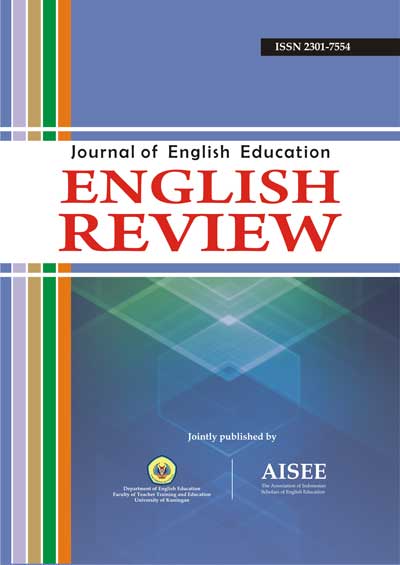THE STUDENTS’ AND TEACHERS’ PERCEPTION ON THE USE OF COMPUTER IN EFL CLASSROOMS
Abstract
Abstract: This research portrays the possibility of the computer used in the EFL classrooms, particularly in senior high school which focuses on the students’ and teachers’ perception on the use of computer in EFL classroom. The data from interview were transcribed and used to support the data from questionnaire. As an alternative learning device, computer helped the students to reach their goals in learning English, i.e.: the limited mastery of vocabulary, the lack of tenses knowledge, focused on speaking and listening, the learning program was too difï¬cult to follow, no speech media (like microphone or headset), no equal chance in using computer because they had to share one computer with the whole class. For teacher, such strategy gave a different experience of way of teaching, a more creative method and material, a fun learning for the students, and many exposures of communicative dialogue. Moreover, using computer in EFL classroom provided with some difï¬culties associated with the EFL situation, such as a large class sizes and mixed ability classrooms.
Keywords: Computer, Perception, EFL Classroom
References
Alwasilah, A. C. (2002). Pokoknya kualitatif: dasar dasar merancang dan melakukan penefitian kualitatif. Jakarta: Pustaka Jaya.
Brown, H. D. (2001). Teaching by principles: An interactive approach to language pedagogy. Second Edition. New York: Longman
Brown, H. D. (2000). Principles of language learning and teaching. New York: Longman.
Coolidge, F. (2000). Statictics: a gentle introduction. London: Sage Publication.
Departemen Pendidikan Nasional. (2004). Invervice training kbk bagi guru penerima.
Dana Bantuan Operasional Mutu Management: Bahasa Inggris. Lembaga Penjamin Mutu Pendidikan, Jawa Barat.
Departemen Pendidikan Nasional. (2006). Rencana strategi pembangunan pendidikan nasional 2005 2009. Jakarta: Departemen Pendidikan Nasional
Eysenck, M. W. (1983). Principles of cognitive psychology. Lawrence Erlbaum Associates Ltd.
Forgus, Ronald H. (1966). Perception: The basic process in cognitive development. McGraw Hill Book Company¬
Fransiska, S. (2000). Students' perception on EBE. Unpublished paper. Bandung Indonesia University of Education.
Harme. J. (2002). The practice of English language teaching. 3rd Edition Completely Revised and Updated. Harlow: Pearson Education Limited.
Harvey, J. H. and Smith, W. P. (1977). Social psychology: An attributional approach. Sain Louis CV Mosbo, Co.
Jackson, P. (2002). Multimedia in the classroom at http://www.pt.britishcouncil.org/inenglish/ie2002a32pj.htm. [June 17th 2004].
Kenning, M. J. and Kenning M M. (1983). An introduction to computer assisted language teaching. Oxford: Oxford University Press.
Kenning, M. M & Kenning, M. J. (1990). Computers and language learning: current theory and practice. New York: Ellis Horwood.
Lukmana, Iwa. 2003. Language teaching media (modul 1): Pembelajaran bahasa Inggris. Bandung: Universitas Terbuka.
Mar'at. (1982). Sikap manusia perubahan serta pengukurannya. Jakarta: Ghalia, Indonesia.
Maxwell, J. A. (1996). Qualitative research design: An interactive approach. California: Sage Publications, Inc.
Oxford University. (2004). Using multimedia in the EFL classroom. at http://www.oup.com/elt/global/multimedia/cataloque/multimedia/multimedia_article/. [June 17th 2004]
Partridge, B. (2000). Making sense of discourse analysis: Making sense of language series book 3. Queensland: Gerd Stables Antipodean Education Enterprises.
Richards, J. C. and Willy A. R. (2002). Methology in language teaching: An anthology of curren practice. Cambridge: Cambridge University Press.
Schiffman, H. R. (1982). Sensation and perception: An integrated Approach 2nd Edition. John Wiley and Sons, Inc.
Skehan 1985. Computers in English Language Teaching. ELT Document,122.
Stern, H. H. (1983). Fundamental concepts of language teaching. Oxford: Oxford University Press
All articles published in English Review: Journal of English Education (ERJEE) are licensed under the Creative Commons Attribution 4.0 International License (CC BY 4.0).
Copyright Ownership
Authors retain the copyright of their articles and grant ERJEE the right of first publication. The journal is granted a non-exclusive license to publish, reproduce, and distribute the article in any format, medium, or platform, provided that proper credit is given to the original authors.
License Terms – CC BY 4.0
Under the Creative Commons Attribution 4.0 International License, others are free to:
- Share — copy and redistribute the material in any medium or format
- Adapt — remix, transform, and build upon the material for any purpose, even commercially
As long as they:
- Provide appropriate credit to the original author(s) and source
- Provide a link to the license (https://creativecommons.org/licenses/by/4.0/)
- Indicate if any changes were made
There are no restrictions on the reuse, reproduction, or adaptation of published articles as long as attribution is properly given.
Author Warranties
By submitting a manuscript to ERJEE, authors confirm that:
- The work is original and does not infringe any existing copyright.
- The manuscript has not been previously published and is not under consideration elsewhere.
- All sources and references are appropriately acknowledged.
- Necessary permissions have been obtained for any copyrighted materials used.










